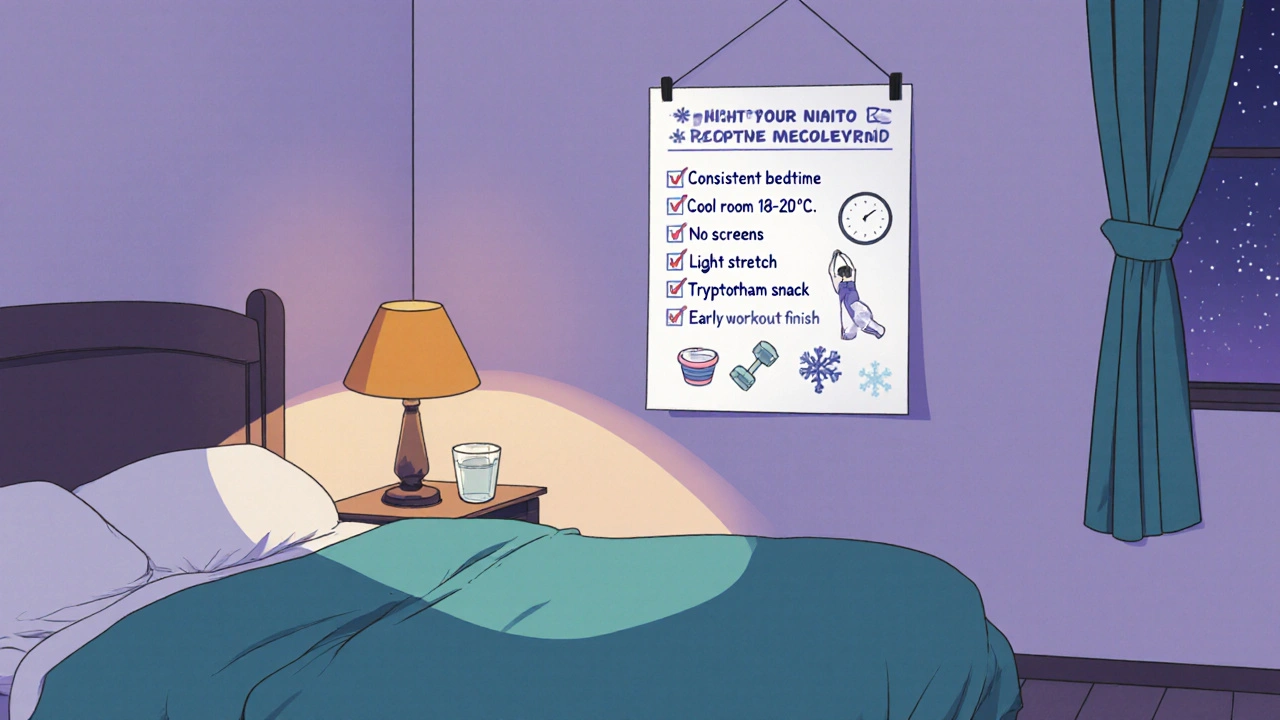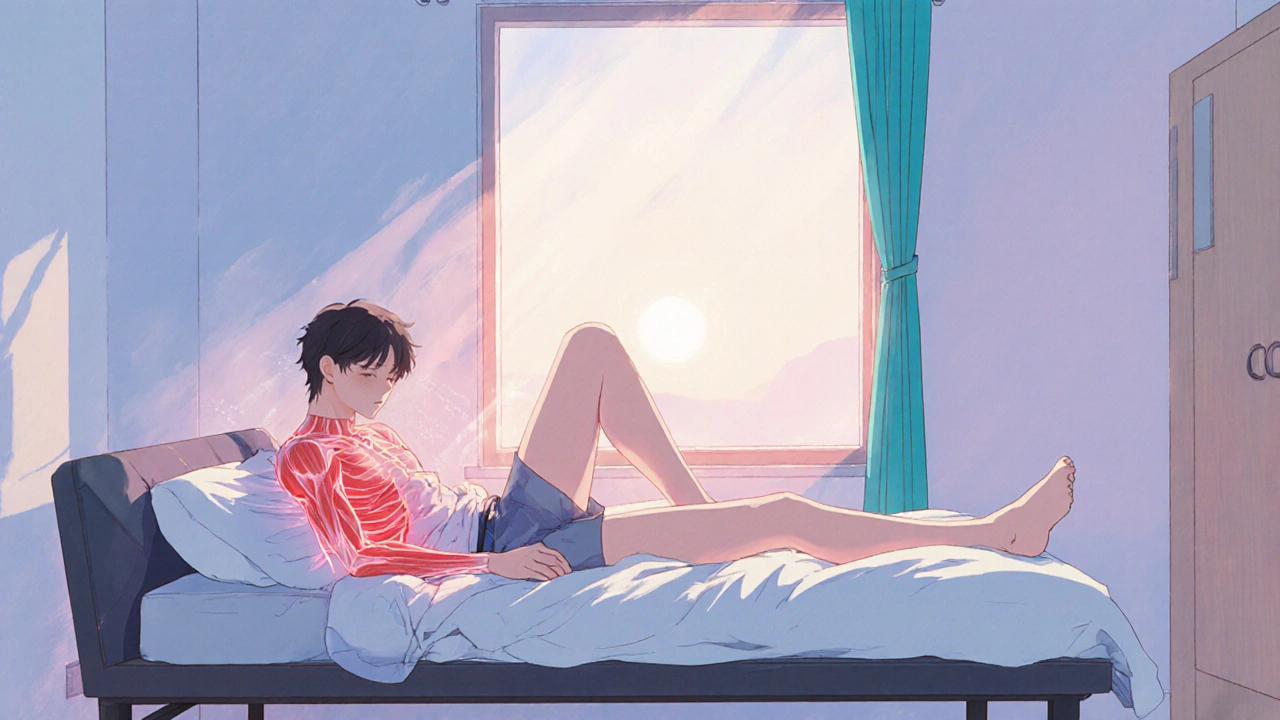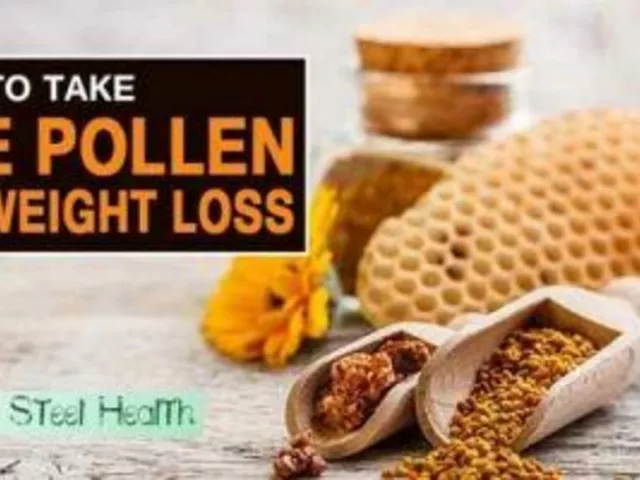Muscle Recovery Sleep Calculator
Optimize Your Sleep for Muscle Recovery
Enter your typical nightly sleep duration to see how it affects your muscle pain and recovery.
Your Muscle Recovery Profile
Enter your sleep duration to see results
Ever woken up feeling like your body was a roadmap of sore spots? You’re not imagining it-your night’s sleep can actually turn the volume up or down on muscle aches. The trick isn’t just more hours; it’s the right mix of deep, REM, and uninterrupted rest.
Key Takeaways
- Both too little and too much sleep can worsen muscle pain.
- Deep (slow‑wave) sleep is the gold standard for muscle recovery.
- Consistent bedtime, cool room, and light exposure shape the circadian rhythm that drives healing.
- Inflammation, cortisol, and melatonin are the hormonal messengers that link sleep quality to soreness.
- Simple tweaks-stretch before bed, moderate evening exercise, and a screen‑free wind‑down-can balance sleep and reduce aches.
Below we dig into the science, map out practical steps, and give you a quick reference table to match your nightly habits with muscle‑pain outcomes.
What Sleep is the natural, reversible state of reduced consciousness that restores body functions actually does for muscles
When you close your eyes, the body doesn’t just idle. Hormones, blood flow, and cellular repair kick into high gear. During the deepest phase-known as slow‑wave or deep sleep-growth hormone spikes, fueling protein synthesis that rebuilds strained fibers. Meanwhile, REM sleep trims down stress hormones like cortisol, which otherwise keep muscles in a tension‑ready state.
Why Muscle Aches are the sensation of soreness, stiffness, or pain in skeletal muscles, often after exertion or inflammation flare up after a poor night’s rest
Muscle pain isn’t just a nuisance; it’s a signal that repair processes are lagging. Two main culprits link bad sleep to aches:
- Inflammation. Lack of deep sleep raises pro‑inflammatory cytokines (IL‑6, TNF‑α). Those molecules make nerves more sensitive, translating tiny micro‑tears into throbbing pain.
- Hormonal imbalance. High cortisol means the body stays in catabolic mode, breaking down tissue rather than rebuilding it. Low melatonin reduces antioxidant protection, slowing recovery.
When you get enough uninterrupted deep sleep, the opposite happens-cytokine levels drop, cortisol falls, and melatonin peaks, creating a biochemical environment that eases soreness.
How much sleep is ideal for minimizing muscle pain?
Most health bodies recommend 7-9 hours for adults. But the sweet spot for muscle recovery leans toward the higher end, especially for active people. Here’s a quick snapshot:
| Sleep Category | Typical Hours | Deep‑Sleep % (of total) | Muscle Ache Frequency |
|---|---|---|---|
| Short | <6 | 10‑15% | High (daily) |
| Recommended | 7‑9 | 20‑25% | Moderate (2‑3 weeks) |
| Long | >9 | 15‑20% | Low (rare) |
Notice the dip in deep‑sleep percentage once you exceed 9 hours. Too much time in bed can fragment sleep stages, actually reducing the restorative portion you need.

Key players that connect sleep and muscle health
Understanding the biochemical trio helps you fine‑tune habits:
- Inflammation: Triggered by cytokines; kept in check by deep sleep.
- Cortisol: Peaks in the early morning; suppressed during uninterrupted REM.
- Melatonin: Night‑time hormone that powers antioxidant defenses and improves sleep depth.
When these are balanced, muscle repair proceeds smoothly; when they’re off‑kilter, soreness spikes.
Practical steps to optimize sleep for muscle recovery
Here’s a nightly checklist that blends science with real‑world convenience:
- Set a consistent bedtime. Aim for the same clock time, even on weekends, to lock in your circadian rhythm.
- Cool your bedroom. 18‑20 °C (64‑68 °F) promotes deep‑sleep hormone release.
- Limit blue‑light exposure. Switch off screens at least 30 minutes before bed; use amber filters if you must use devices.
- Mind your evening nutrition. A small snack with tryptophan (e.g., yogurt, turkey) can boost melatonin. Avoid caffeine after 2 p.m.
- Gentle stretch or foam‑roll. Light mobility work reduces muscle tension without spiking cortisol.
- Schedule intense workouts earlier. Finish high‑intensity cardio or heavy lifting at least 3 hours before sleep to allow cortisol to fall.
- Consider a short nap. If you’re short on night sleep, a 20‑minute nap can restore alertness without interfering with deep‑sleep cycles.
When sleep isn’t enough: other factors that influence muscle aches
Even perfect sleep can’t fully offset other pain drivers. Keep an eye on these:
- Hydration. Dehydrated muscles are more prone to cramping and soreness.
- Electrolyte balance. Low magnesium or potassium can prolong recovery.
- Posture and ergonomics. Bad desk setup creates chronic tension that mirrors lack of sleep.
- Stress management. Psychological stress raises cortisol, negating nighttime cortisol drops.
Integrating these with sleep‑focused habits gives a holistic approach to beating aches.

Common pitfalls and how to avoid them
Many people think ‘more sleep = better recovery,’ but the reality is subtler:
| Myth | Fact |
|---|---|
| Sleeping 10+ hours always helps muscles. | Excessive sleep fragments cycles, reducing deep‑sleep proportion. |
| Only total hours matter. | Sleep continuity and stage distribution matter more for recovery. |
| Alcohol helps you fall asleep fast. | Alcohol suppresses REM and deep sleep, increasing next‑day soreness. |
| Late‑night cardio is fine if you’re tired. | Intense evening exercise spikes cortisol, delaying muscle repair. |
Spotting these traps early saves weeks of unnecessary discomfort.
Tracking progress: simple metrics to monitor
Use a notebook or a health app to log:
- Hours of sleep (total and estimated deep‑sleep).
- Morning muscle soreness rating (1‑10 scale).
- Exercise intensity and timing.
- Stressor events (work deadlines, travel, caffeine).
After two weeks, look for trends. If soreness drops when deep‑sleep rises, you’ve got a winning formula.
Frequently Asked Questions
Can I recover from a sore muscle without changing my sleep?
You can ease pain with stretching, hydration, and over‑the‑counter anti‑inflammatories, but without adequate deep‑sleep the underlying repair processes stay sluggish. Expect slower long‑term recovery.
Is napping beneficial for muscle recovery?
A brief 20‑minute nap can boost alertness and modestly raise growth‑hormone spikes, but longer naps (>60 min) often cause sleep inertia and cut into nighttime deep‑sleep, which is less helpful.
How does alcohol affect muscle aches?
Alcohol initially makes you drowsy, but it disrupts REM and deep‑sleep cycles, leading to higher nighttime inflammation markers. The net effect is more soreness the next day.
What’s the best bedtime routine for athletes?
Cool the room, dim lights, do 5‑10 minutes of gentle stretching, consume a protein‑rich snack with tryptophan, and shut screens at least 30 minutes before lights out. Stick to the same bedtime daily.
Can supplements improve sleep‑related muscle recovery?
Magnesium and zinc can calm nerves and support deep‑sleep length, while omega‑3 fatty acids reduce inflammation. They’re helpful adjuncts, not replacements for good sleep hygiene.
Putting it all together
Think of sleep as the nightly workshop where your muscles get repaired, rebuilt, and re‑energized. By aligning bedtime, bedroom environment, and evening activities, you create the perfect conditions for deep‑sleep hormones to do their job. The payoff? Fewer morning aches, stronger performance, and a body that feels ready for the next day’s challenges.
Start small-pick one habit from the checklist, track your sleep and soreness for a week, and tweak as needed. The balance isn’t a one‑size‑fits‑all formula, but the science is clear: the right kind of sleep is a cornerstone of muscle health.





Comments (8)